清晖园英文介绍(英文版)
- 格式:docx
- 大小:51.92 KB
- 文档页数:8
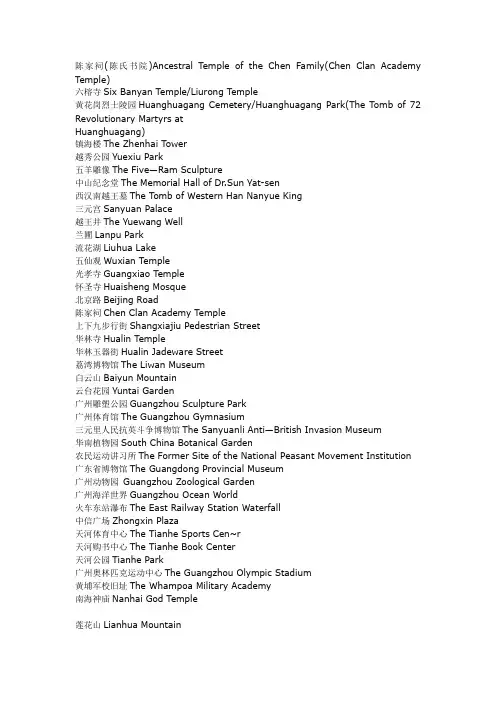
陈家祠(陈氏书院)Ancestral Temple of the Chen Family(Chen Clan Academy Temple)六榕寺Six Banyan Temple/Liurong Temple黄花岗烈士陵园Huanghuagang Cemetery/Huanghuagang Park(The Tomb of 72 Revolutionary Martyrs atHuanghuagang)镇海楼The Zhenhai Tower越秀公园Yuexiu Park五羊雕像The Five—Ram Sculpture中山纪念堂The Memorial Hall of Dr.Sun Yat-sen西汉南越王墓The Tomb of Western Han Nanyue King三元宫Sanyuan Palace越王井The Yuewang Well兰圃Lanpu Park流花湖Liuhua Lake五仙观Wuxian Temple光孝寺Guangxiao Temple怀圣寺Huaisheng Mosque北京路Beijing Road陈家祠Chen Clan Academy Temple上下九步行街Shangxiajiu Pedestrian Street华林寺Hualin Temple华林玉器街Hualin Jadeware Street荔湾博物馆The Liwan Museum白云山Baiyun Mountain云台花园Yuntai Garden广州雕塑公园Guangzhou Sculpture Park广州体育馆The Guangzhou Gymnasium三元里人民抗英斗争博物馆The Sanyuanli Anti—British Invasion Museum华南植物园South China Botanical Garden农民运动讲习所The Former Site of the National Peasant Movement Institution 广东省博物馆The Guangdong Provincial Museum广州动物园Guangzhou Zoological Garden广州海洋世界Guangzhou Ocean World火车东站瀑布The East Railway Station Waterfall中信广场Zhongxin Plaza天河体育中心The Tianhe Sports Cen~r天河购书中心The Tianhe Book Center天河公园Tianhe Park广州奥林匹克运动中心The Guangzhou Olympic Stadium黄埔军校旧址The Whampoa Military Academy南海神庙Nanhai God Temple莲花山Lianhua Mountain宝墨园Baomo Garden余荫园Yuyin Garden长隆夜间野生动物园Changlong Night Zoo南沙天后宫The Nansha Tianhou Palace孙中山大元帅府纪念馆The Sun Yet-sen's Generalissimo Mansion海幢寺Haizhuang Temple瀛洲生态公园Yingzhou Ecological Park芙蓉嶂旅游度假区The Furongzhang Holiday Resod盘古皇庙Panguhuang Temple洪秀全纪念馆The Memorial Museum of Hong Xiuquan花都广场Huadu Square珠江沿岸景观The Landscapes along the Zhujiang River珠江航游The Zhuiiang River Cruise沙面岛Shamian Island南方大厦The Nanfang Mansion爱群大厦The Aiqun Mansion海珠广场Haizhu Plaza石室圣心大教堂The Sacred Heart Cathedral二沙岛Ersha Island广州国际会展中心The Guangzhou International Convention and Exhibition Center 北回归线广州标志塔The Guangzhou Marking T ower of the Tropic of Cancer从化温泉度假区The Conghua Hot Spring Resort天湖游览区The Tianhu Sightseeing Zone流溪河国家森林公园Liuxihe National Forest Park白水寨省级风景名胜区The Baishuizhai Provincial Scenic Spot何仙姑家庙Hexiangu Temple挂绿广场Gual0 Plaza鸦片战争纪念馆The Museum of the Opium War佛山市Foshan city梁园Liang Garden清晖园Qinghui Garden佛山祖庙Foshan Ancestral Temple黄飞鸿纪念堂The Memorial Hal l of Huang Feihong西樵山度假区The Xiqiao Mountain T ourist Resort鼎湖山度假区The Dinghu Mountain T ourist Resort迎春花市The Spring Festival Flower Fair舞狮The Lion Dance元宵节The Lantern Festival重阳节The Double—Ninth Festival龙舟节The Dragon Boat Festival南海神诞辰(波罗诞)The Birthday of the God of the South Sea(The Boluo Dan)番禺莲花节The Lotus Festival in Panyu中秋节The Mid-Autumn DayGuangzhou History.from googleearthIt is believed that the first city built at the site of Guangzhou was Panyu (蕃禺, later si mplifed to 番禺; the locals pronounced this in Cantonese as Poon Yu) founded in 214 B C. The city has been continuously occupied since that time. Panyu was expanded when it became the capital of the Nanyue Kingdom (南越) in 206 BC.Recent archaeological founding of her palace suggests that the city might have traded f requently with foreigners by the sea routes. The foreign trade continued through every following dynasty and the city rem ains a major international trading port to this day. The Han Dynasty annexed Nanyue in 111 BC, and Panyu became a provincial capital a nd remains so until this day. In 226 AD, the city became the seat of the Guang Prefec ture (廣州; Guangzhou). Therefore, 'Guangzhou' was the name of the prefecture, not of the city. However, people grew accustomed to calling the city Guangzhou, instead of P anyu.Although the Chinese nam e of Guangzhou replaced Panyu as the nam e of the walled ci ty, Panyu was still the name of the area surrounding the walled city until the end of Qi ng era.Arabs and Persians sacked Guangzhou (known to them as Sin-Kalan) in AD 758, 2 acc ording to a local Guangzhou governm ent report on October 30, 758, which corresponde d to the day of Guisi (癸巳) of the ninth lunar month in the first year of the Qianyuan era of Emperor Suzong of the Tang Dynasty.[1][2][3]During the Northern Song Dynasty, a celebrated poet called Su Shi visited Guangzhou's Baozhuangyan Temple and wrote the inscription 'Liu Rong' (Six Banyan Trees) becaus e of the six banyan trees he saw there. It has since been called the Temple of the Six Banyan Trees.The Portuguese were the first Europeans to arrive to the city by sea, obtaining the mo nopoly for external trade with its harbour by 1511. They were later expelled from theirsettlements in Guangzhou (in Portuguese Canton or Cantao), but instead granted use of Macao (first occupied in 1511) as a trade base with the city in 1557. They would ke ep a near monopoly of foreign trade in the region until the arrival of the Dutch in the early XVII century.After China brought Taiwan under its control in 1683, the Qing government became op en to encouraging foreign trade. Guangzhou quickly emerged as one of the most adapt able ports for negotiating commerce and before long, many foreign ships were going th ere to procure cargos. Portuguese in Macao, Spanish in Manila, and Armenians and Mu slims from India were already actively trading in the port by the 1690s, when the Fren ch and English East India companies' ships began frequenting the port. Other companie s were soon to follow: the Ostend General India Company in 1717; Dutch East India C ompany in 1729; the first Danish ship in 1731, which was followed by a Danish Asiatic Company ship in 1734; the Swedish East India Company in 1732; followed by an occa sional Prussian and Trieste Company ship; the Americans in 1784; and the first ships f rom Australia in 1788. By the middle of the 18th century, Guangzhou had emerged as one of the world's great trading ports, which was a distinction it maintained until the o utbreak of the Opium War in 1839 and the opening of other ports in China in 1842. Guangzhou was one of the five Chinese treaty ports opened by the Treaty of Nanking (signed in 1842) at the end of the First Opium War between Britain and China. The ot her ports were Fuzhou, Xiamen, Ningbo, and Shanghai.In 1918, 'Guangzhou' became the official name of the city, when an urban council was established in it. Panyu became a county's name south of Guangzhou. In both 1930 a nd 1953, Guangzhou was promoted to the status of a Municipality, but each promotion was cancelled within the year.Japanese troops occupied Guangzhou from 1938-10-12 to 1945-09-16.Communist forces entered the city on October 14, 1949. Their urban renewal projects improved the lives of many residents. New housing on the shores of the Pearl River pro vided homes for the poor boat people. Reforms by Deng Xiaoping, who came to power in the late 1970s, led to rapid economic growth due to the city's close proximity to H ong Kong and access to the Pearl River.As labor costs increased in Hong Kong, manufacturers opened new plants in the cities of Guangdong including Guangzhou. As the largest city in one of China's wealthiest pro vinces, Guangzhou attracts farmers from the countryside looking for factory work. Cant onese links to overseas Chinese and beneficial tax reforms of the 1990s have aided th e city's rapid growth.In 2000, Huadu and Panyu were merged into Guangzhou as districts, and Conghua and Zengcheng becam e county-level cities of Guangzhou.。
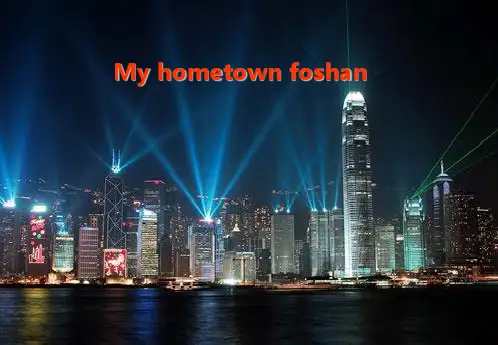
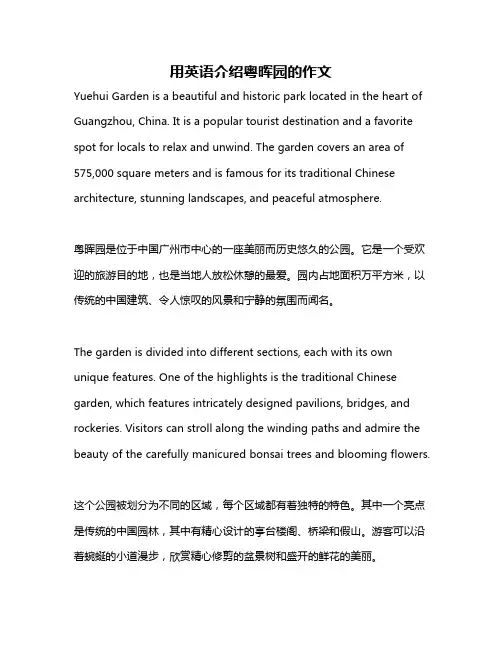
用英语介绍粤晖园的作文Yuehui Garden is a beautiful and historic park located in the heart of Guangzhou, China. It is a popular tourist destination and a favorite spot for locals to relax and unwind. The garden covers an area of 575,000 square meters and is famous for its traditional Chinese architecture, stunning landscapes, and peaceful atmosphere.粤晖园是位于中国广州市中心的一座美丽而历史悠久的公园。
它是一个受欢迎的旅游目的地,也是当地人放松休憩的最爱。
园内占地面积万平方米,以传统的中国建筑、令人惊叹的风景和宁静的氛围而闻名。
The garden is divided into different sections, each with its own unique features. One of the highlights is the traditional Chinese garden, which features intricately designed pavilions, bridges, and rockeries. Visitors can stroll along the winding paths and admire the beauty of the carefully manicured bonsai trees and blooming flowers.这个公园被划分为不同的区域,每个区域都有着独特的特色。
其中一个亮点是传统的中国园林,其中有精心设计的亭台楼阁、桥梁和假山。

粤西景点介绍作文英文英文:When it comes to tourist attractions in western Guangdong, there are many wonderful places to visit. One of the most popular is the Kaiping Diaolou and Villages. These unique structures were built in the early 20th century and are a combination of Chinese and Western architectural styles. The Diaolou were originally built as watchtowers to protect against bandits and floods, but they also served as living quarters for wealthy families. Today, visitors can explore the Diaolou and learn about the history and culture of the region.Another must-see attraction in western Guangdong is the Xinhui Guifeng Mountain Scenic Area. This natural wonder is home to stunning waterfalls, lush forests, and breathtaking mountain views. Visitors can hike along the trails, take a dip in the crystal-clear pools, or simply relax and enjoy the peaceful surroundings. One of the highlights of thearea is the Guifeng Mountain Temple, which dates back tothe Tang Dynasty and is a popular pilgrimage site for Buddhists.中文:说到广东西部的旅游景点,有很多美丽的地方值得去。
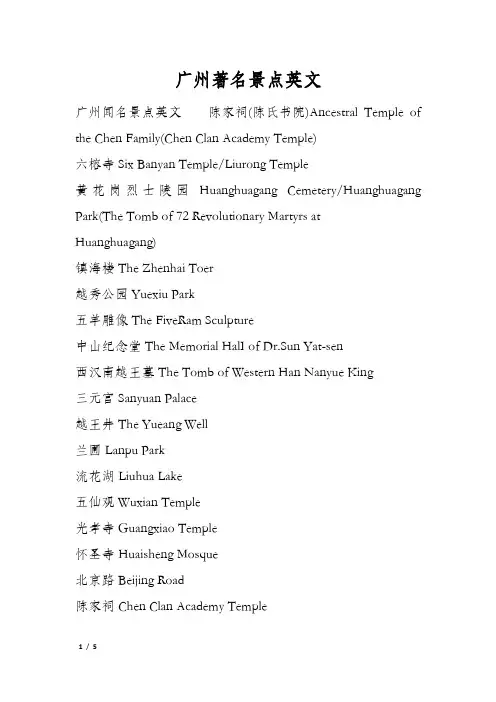
广州著名景点英文广州闻名景点英文陈家祠(陈氏书院)Ancestral Temple of the Chen Family(Chen Clan Academy Temple)六榕寺Six Banyan Temple/Liurong Temple黄花岗烈士陵园Huanghuagang Cemetery/Huanghuagang Park(The Tomb of 72 Revolutionary Martyrs at Huanghuagang)镇海楼The Zhenhai Toer越秀公园Yuexiu Park五羊雕像The FiveRam Sculpture中山纪念堂The Memorial HalI of Dr.Sun Yat-sen西汉南越王墓The Tomb of Western Han Nanyue King三元宫Sanyuan Palace越王井The Yueang Well兰圃Lanpu Park流花湖Liuhua Lake五仙观Wuxian Temple光孝寺Guangxiao Temple怀圣寺Huaisheng Mosque北京路Beijing Road陈家祠Chen Clan Academy Temple上下九步行街Shangxiajiu Pedestrian Street华林寺Hualin Temple华林玉器街Hualin Jadeare Street荔湾博物馆The Lian Museum白云山Baiyun Mountain云台花园Yuntai Garden广州雕塑公园Guangzhou Sculpture Park广州体育馆The Guangzhou Gymnasium三元里人民抗英斗争博物馆The Sanyuanli AntiBritish Invasion Museum华南植物园South China Botanical Garden农夫运动讲习所The Former Site of the National Peasant Movement Institution广东省博物馆The Guangdong Provincial Museum广州动物园Guangzhou Zoological Garden广州海洋世界Guangzhou Ocean World火车东站瀑布The East Railay Station Waterfall中信广场Zhongxin Plaza天河体育中心The Tianhe Sports Cen~r天河购书中心The Tianhe Book Center天河公园Tianhe Park广州奥林匹克运动中心The Guangzhou Olympic Stadium黄埔军校旧址The Whampoa Military Academy南海神庙Nanhai God TemplePart 2 as belo:--------------------------------------莲花山Lianhua Mountain宝墨园Baomo Garden余荫园Yuyin Garden长隆夜间野生动物园Changlong Night Zoo南沙天后宫The Nansha Tianhou Palace孙中山大元帅府纪念馆The Sun Yet-sen's Generalissimo Mansion广州闻名景点英文海幢寺Haizhuang Temple瀛洲生态公园Yingzhou Ecological Park芙蓉嶂旅游度假区The Furongzhang Holiday Resod盘古皇庙Panguhuang Temple洪秀全纪念馆The Memorial Museum of Hong Xiuquan花都广场Huadu Square珠江沿岸景观The Landscapes along the Zhujiang River珠江航游The Zhuiiang River Cruise沙面岛Shamian Island南方大厦The Nanfang Mansion爱群大厦The Aiqun Mansion海珠广场Haizhu Plaza石室圣心大教堂The Sacred Heart Cathedral二沙岛Ersha Island广州国际会展中心The Guangzhou International Convention and Exhibition Center北回归线广州标志塔The Guangzhou Marking Toer of the Tropic of Cancer从化温泉度假区The Conghua Hot Spring Resort天湖巡游区The Tianhu Sightseeing Zone流溪河国家森林公园Liuxihe National Forest Park白水寨省级风景名胜区The Baishuizhai Provincial Scenic Spot 何仙姑家庙Hexiangu Temple挂绿广场Gual0 Plaza鸦片战斗纪念馆The Museum of the Opium War佛山市Foshan city梁园Liang Garden清晖园Qinghui Garden佛山祖庙Foshan Ancestral Temple黄飞鸿纪念堂The Memorial Hal l of Huang Feihong西樵山度假区The Xiqiao Mountain Tourist Resort鼎湖山度假区The Dinghu Mountain Tourist Resort迎春花市The Spring Festival Floer Fair舞狮The Lion Dance元宵节The Lantern Festival重阳节The DoubleNinth Festival龙舟节The Dragon Boat Festival南海神诞辰(波罗诞)The Birthday of the God of the South Sea(The Boluo Dan)番禺莲花节The Lotus Festival in Panyu中秋节The Mid-Autumn Day。
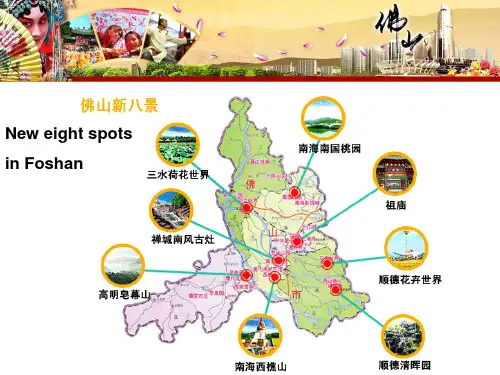

广州名胜古迹英文名称大全第一篇:广州名胜古迹英文名称大全陈家祠(陈氏书院)Ancestral Temple of the Chen Family(Chen Clan Academy Temple)六榕寺Six Banyan Temple/Liurong Temple 黄花岗烈士陵园Huanghuagang Cemetery/Huanghuagang Park(The T omb of 72 Revolutionary Martyrs at Huanghuagang) 镇海楼The Zhenhai Tower 越秀公园Yuexiu Park 五羊雕像The Five—Ram Sculpture 中山纪念堂The Memorial Hall of Dr.Sun Yat-sen 西汉南越王墓The Tomb of Western Han Nanyue King 三元宫Sanyuan Palace 越王井The Yuewang Well 兰圃Lanpu Park 流花湖Liuhua Lake 五仙观Wuxian Temple 光孝寺Guangxiao Temple 怀圣寺Huaisheng Mosque 北京路Beijing Road 陈家祠Chen Clan Academy T emple 上下九步行街Shangxiajiu Pedestrian Street 华林寺Hualin Temple 华林玉器街Hualin Jadeware Street 荔湾博物馆The Liwan Museum 白云山Baiyun Mountain 云台花园Yuntai Garden 广州雕塑公园Guangzhou Sculpture Park 广州体育馆The Guangzhou Gymnasium 三元里人民抗英斗争博物馆The Sanyuanli Anti—British Invasion Museum 华南植物园South China Botanical Garden 农民运动讲习所The Former Site of the National Peasant Movement Institution 广东省博物馆The Guangdong Provincial Museum 广州动物园 Guangzhou Zoological Garden 广州海洋世界Guangzhou Ocean World 火车东站瀑布The East Railway Station Waterfall 中信广场Zhongxin Plaza 天河体育中心The Tianhe Sports Cen~r 天河购书中心The Tianhe Book Center 天河公园Tianhe Park 广州奥林匹克运动中心The Guangzhou Olympic Stadium 黄埔军校旧址The Whampoa Military Academy 南海神庙Nanhai God Temple莲花山Lianhua Mountain宝墨园Baomo Garden余荫园Yuyin Garden 长隆夜间野生动物园Changlong Night Zoo 南沙天后宫The Nansha Tianhou Palace 孙中山大元帅府纪念馆The Sun Yet-sen's Generalissimo Mansion 海幢寺Haizhuang Temple 瀛洲生态公园Yingzhou Ecological Park 芙蓉嶂旅游度假区The Furongzhang Holiday Resod 盘古皇庙Panguhuang T emple 洪秀全纪念馆The Memorial Museum of Hong Xiuquan 花都广场Huadu Square 珠江沿岸景观The Landscapes along the Zhujiang River 珠江航游The Zhuiiang River Cruise 沙面岛Shamian Island 南方大厦The Nanfang Mansion 爱群大厦The Aiqun Mansion 海珠广场Haizhu Plaza 石室圣心大教堂The Sacred Heart Cathedral 二沙岛Ersha Island 广州国际会展中心The Guangzhou International Convention and Exhibition Center 北回归线广州标志塔The Guangzhou Marking Tower of the Tropic of Cancer 从化温泉度假区The Conghua Hot Spring Resort 天湖游览区The Tianhu Sightseeing Zone 流溪河国家森林公园Liuxihe National Forest Park 白水寨省级风景名胜区The Baishuizhai Provincial Scenic Spot 何仙姑家庙Hexiangu Temple 挂绿广场Gual0 Plaza 鸦片战争纪念馆The Museum of the Opium War 佛山市Foshan city 梁园Liang Garden 清晖园Qinghui Garden 佛山祖庙Foshan Ancestral Temple 黄飞鸿纪念堂The Memorial Hal l of Huang Feihong 西樵山度假区The Xiqiao Mountain Tourist Resort 鼎湖山度假区The Dinghu Mountain Tourist Resort 迎春花市The Spring Festival Flower Fair 舞狮The Lion Dance 元宵节The Lantern Festival 重阳节The Double—Ninth Festival 龙舟节The Dragon Boat Festival 南海神诞辰(波罗诞)The Birthday of the God of the South Sea(The Boluo Dan)番禺莲花节The Lotus Festival in Panyu 中秋节The Mid-Autumn DayGuangzhou History.from googleearth It is believed that the first city built at the site of Guangzhou was Panyu(蕃禺, later simplifed to 番禺;the locals pronounced this in Cantonese asPoon Yu)founded in 214 BC.The city has been continuously occupied since that time.Panyu was expanded when it became the capital of the Nanyue Kingdom(南越)in 206 BC.Recent archaeological founding of her palace suggests that the city might have traded frequently with foreigners by the sea routes.The foreign trade continued through every following dynasty and the city remains a major international trading port to this day.The Han Dynasty annexed Nanyue in 111 BC, and Panyu became a provincial capital and remains so until this day.In 226 AD, the city became the seat of the Guang Prefecture(廣州;Guangzhou).Therefore, 'Guangzhou' was the name of the prefecture, not of the city.However, people grew accustomed to calling the city Guangzhou, instead of Panyu.Although the Chinese name of Guangzhou replaced Panyu as the name of the walled city, Panyu was still the name of the area surrounding the walled city until the end of Qing era.Arabs and Persians sacked Guangzhou(known to them as Sin-Kalan)in AD 758, 2 according to a local Guangzhou government report on October 30, 758, which corresponded to the day of Guisi(癸巳)of the ninth lunar month in the first year of the Qianyuan era of Emperor Suzong of the Tang Dynasty.[1][2][3] During the Northern Song Dynasty, a celebrated poet called Su Shi visited Guangzhou's Baozhuangyan Temple and wrote the inscription 'Liu Rong'(Six Banyan Trees)because of the six banyan trees he saw there.It has since been called the Temple of the Six Banyan Trees.The Portuguese were the first Europeans to arrive to the city by sea, obtaining the monopoly for external trade with its harbour by 1511.They were later expelled from theirsettlements in Guangzhou(in Portuguese Canton or Cantao), but instead granted use of Macao(first occupied in 1511)as atrade base with the city in 1557.They would keep a near monopoly of foreign trade in the region until the arrival of the Dutch in the early XVII century.After China brought Taiwan under its control in 1683, the Qing government became open to encouraging foreign trade.Guangzhou quickly emerged as one of the most adaptable ports for negotiating commerce and before long, many foreign ships were going there to procure cargos.Portuguese in Macao, Spanish in Manila, and Armenians and Muslims from India were already actively trading in the port by the 1690s, when the French and English East India companies' ships began frequenting the port.Other companies were soon to follow: the Ostend General India Company in 1717;Dutch East India Company in 1729;the first Danish ship in 1731, which was followed by a Danish Asiatic Company ship in 1734;the Swedish East India Company in 1732;followed by an occasional Prussian and Trieste Company ship;the Americans in 1784;and the first ships from Australia in 1788.By the middle of the 18th century, Guangzhou had emerged as one of the world's great trading ports, which was a distinction it maintained until the outbreak of the Opium War in 1839 and the opening of other ports in China in 1842.Guangzhou was one of the five Chinese treaty ports opened by the Treaty of Nanking(signed in 1842)at the end of the First Opium War between Britain and China.The other ports were Fuzhou, Xiamen, Ningbo, and Shanghai.In 1918, 'Guangzhou' became the official name of the city, when an urban council was established in it.Panyu became a county's name south of Guangzhou.In both 1930 and 1953, Guangzhou was promoted to the status of a Municipality, but each promotion was cancelled within the year.Japanese troops occupied Guangzhou from 1938-10-12 to munist forces entered thecity on October 14, 1949.Their urban renewal projects i mproved the lives of many residents.New housing on the shores of the Pearl River provided homes for the poor boat people.Reforms by Deng Xiaoping, who came to power in the late 1970s, led to rapid economic growth due to the city's close proximity to Hong Kong and access to the Pearl River.As labor costs increased in Hong Kong, manufacturers opened new plants in the cities of Guangdong including Guangzhou.As the largest city in one of China's wealthiest provinces, Guangzhou attracts farmers from the countryside looking for factory work.Cantonese links to overseas Chinese and beneficial tax reforms of the 1990s have aided the city's rapid growth.In 2000, Huadu and Panyu were merged into Guangzhou as districts, and Conghua and Zengcheng became county-level cities of Guangzhou.第二篇:英文名称英文名称:SHAWSHANK REDEMPTION小说原著:斯帝芬金(Stephen King),收录于该作者的小说集《四季》(Different Seasons)的第一部:《春》(Hope Springs Eternal—Rita Hayworth and Shawshank Redemption)**Rita是50年代的电影舞蹈明星,嫁给《公民凯恩》的导演奥逊维尔森。
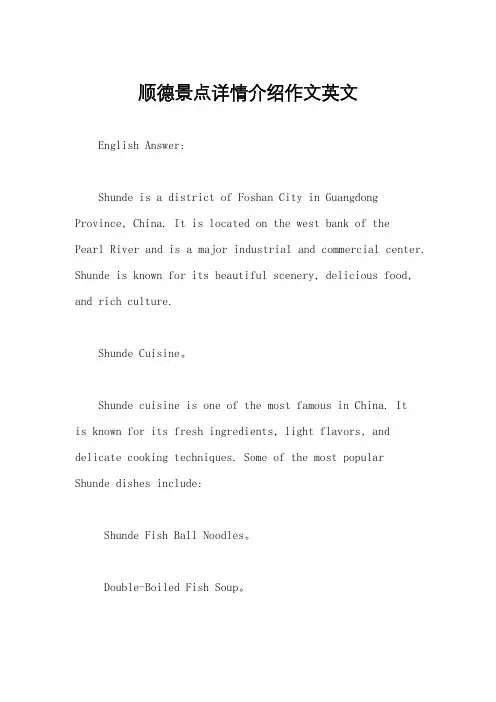
顺德景点详情介绍作文英文English Answer:Shunde is a district of Foshan City in Guangdong Province, China. It is located on the west bank of thePearl River and is a major industrial and commercial center. Shunde is known for its beautiful scenery, delicious food, and rich culture.Shunde Cuisine。
Shunde cuisine is one of the most famous in China. Itis known for its fresh ingredients, light flavors, and delicate cooking techniques. Some of the most popular Shunde dishes include:Shunde Fish Ball Noodles。
Double-Boiled Fish Soup。
Steamed Chicken with Soy Sauce。
Stir-Fried Beef with Chinese Celery。
Baked Stuffed Crab。
Shunde Tourism。
Shunde is a popular tourist destination for both domestic and international visitors. Some of the most popular tourist attractions in Shunde include:Xiqiao Mountain。
Shunde Museum。
Shunde Folk Art Museum。
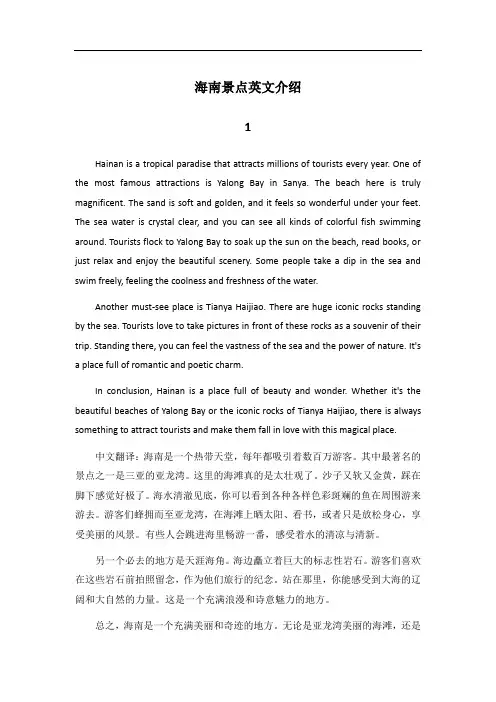
海南景点英文介绍1Hainan is a tropical paradise that attracts millions of tourists every year. One of the most famous attractions is Yalong Bay in Sanya. The beach here is truly magnificent. The sand is soft and golden, and it feels so wonderful under your feet. The sea water is crystal clear, and you can see all kinds of colorful fish swimming around. Tourists flock to Yalong Bay to soak up the sun on the beach, read books, or just relax and enjoy the beautiful scenery. Some people take a dip in the sea and swim freely, feeling the coolness and freshness of the water.Another must-see place is Tianya Haijiao. There are huge iconic rocks standing by the sea. Tourists love to take pictures in front of these rocks as a souvenir of their trip. Standing there, you can feel the vastness of the sea and the power of nature. It's a place full of romantic and poetic charm.In conclusion, Hainan is a place full of beauty and wonder. Whether it's the beautiful beaches of Yalong Bay or the iconic rocks of Tianya Haijiao, there is always something to attract tourists and make them fall in love with this magical place.中文翻译:海南是一个热带天堂,每年都吸引着数百万游客。
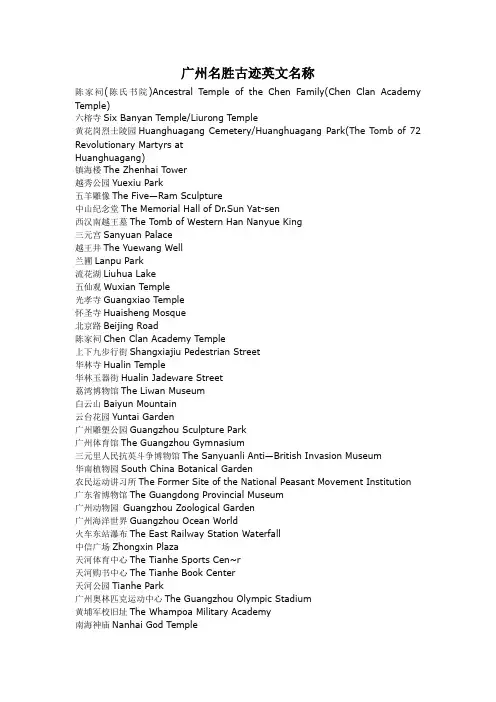
广州名胜古迹英文名称陈家祠(陈氏书院)Ancestral Temple of the Chen Family(Chen Clan Academy Temple)六榕寺Six Banyan Temple/Liurong Temple黄花岗烈士陵园Huanghuagang Cemetery/Huanghuagang Park(The Tomb of 72 Revolutionary Martyrs atHuanghuagang)镇海楼The Zhenhai Tower越秀公园Yuexiu Park五羊雕像The Five—Ram Sculpture中山纪念堂The Memorial Hall of Dr.Sun Yat-sen西汉南越王墓The Tomb of Western Han Nanyue King三元宫Sanyuan Palace越王井The Yuewang Well兰圃Lanpu Park流花湖Liuhua Lake五仙观Wuxian Temple光孝寺Guangxiao Temple怀圣寺Huaisheng Mosque北京路Beijing Road陈家祠Chen Clan Academy Temple上下九步行街Shangxiajiu Pedestrian Street华林寺Hualin Temple华林玉器街Hualin Jadeware Street荔湾博物馆The Liwan Museum白云山Baiyun Mountain云台花园Yuntai Garden广州雕塑公园Guangzhou Sculpture Park广州体育馆The Guangzhou Gymnasium三元里人民抗英斗争博物馆The Sanyuanli Anti—British Invasion Museum华南植物园South China Botanical Garden农民运动讲习所The Former Site of the National Peasant Movement Institution 广东省博物馆The Guangdong Provincial Museum广州动物园Guangzhou Zoological Garden广州海洋世界Guangzhou Ocean World火车东站瀑布The East Railway Station Waterfall中信广场Zhongxin Plaza天河体育中心The Tianhe Sports Cen~r天河购书中心The Tianhe Book Center天河公园Tianhe Park广州奥林匹克运动中心The Guangzhou Olympic Stadium黄埔军校旧址The Whampoa Military Academy南海神庙Nanhai God Temple莲花山Lianhua Mountain宝墨园Baomo Garden余荫园Yuyin Garden长隆夜间野生动物园Changlong Night Zoo南沙天后宫The Nansha Tianhou Palace孙中山大元帅府纪念馆The Sun Yet-sen's Generalissimo Mansion海幢寺Haizhuang Temple瀛洲生态公园Yingzhou Ecological Park芙蓉嶂旅游度假区The Furongzhang Holiday Resod盘古皇庙Panguhuang Temple洪秀全纪念馆The Memorial Museum of Hong Xiuquan花都广场Huadu Square珠江沿岸景观The Landscapes along the Zhujiang River珠江航游The Zhuiiang River Cruise沙面岛Shamian Island南方大厦The Nanfang Mansion爱群大厦The Aiqun Mansion海珠广场Haizhu Plaza石室圣心大教堂The Sacred Heart Cathedral二沙岛Ersha Island广州国际会展中心The Guangzhou International Convention and Exhibition Center 北回归线广州标志塔The Guangzhou Marking Tower of the Tropic of Cancer从化温泉度假区The Conghua Hot Spring Resort天湖游览区The Tianhu Sightseeing Zone流溪河国家森林公园Liuxihe National Forest Park白水寨省级风景名胜区The Baishuizhai Provincial Scenic Spot何仙姑家庙Hexiangu Temple挂绿广场Gual0 Plaza鸦片战争纪念馆The Museum of the Opium War佛山市Foshan city梁园Liang Garden清晖园Qinghui Garden佛山祖庙Foshan Ancestral Temple黄飞鸿纪念堂The Memorial Hal l of Huang Feihong西樵山度假区The Xiqiao Mountain Tourist Resort鼎湖山度假区The Dinghu Mountain Tourist Resort迎春花市The Spring Festival Flower Fair舞狮The Lion Dance元宵节The Lantern Festival重阳节The Double—Ninth Festival龙舟节The Dragon Boat Festival南海神诞辰(波罗诞)The Birthday of the God of the South Sea(The Boluo Dan)番禺莲花节The Lotus Festival in Panyu中秋节The Mid-Autumn DayGuangzhou History.from googleearthIt is believed that the first city built at the site of Guangzhou was Panyu (蕃禺, later si mplifed to 番禺; the locals pronounced this in Cantonese as Poon Yu) founded in 214 B C. The city has been continuously occupied since that time. Panyu was expanded when it became the capital of the Nanyue Kingdom (南越) in 206 BC.Recent archaeological founding of her palace suggests that the city might have traded f requently with foreigners by the sea routes. The foreign trade continued through every following dynasty and the city remains a major international trading port to this day. The Han Dynasty annexed Nanyue in 111 BC, and Panyu became a provincial capital a nd remains so until this day. In 226 AD, the city became the seat of the Guang Prefec ture (廣州; Guangzhou). Therefore, 'Guangzhou' was the name of the prefecture, not of the city. However, people grew accustomed to calling the city Guangzhou, instead of P anyu.Although the Chinese name of Guangzhou replaced Panyu as the name of the walled ci ty, Panyu was still the name of the area surrounding the walled city until the end of Qi ng era.Arabs and Persians sacked Guangzhou (known to them as Sin-Kalan) in AD 758, 2 acc ording to a local Guangzhou government report on October 30, 758, which corresponde d to the day of Guisi (癸巳) of the ninth lunar month in the first year of the Qianyuan era of Emperor Suzong of the Tang Dynasty.[1][2][3]During the Northern Song Dynasty, a celebrated poet called Su Shi visited Guangzhou's Baozhuangyan Temple and wrote the inscription 'Liu Rong' (Six Banyan Trees) becaus e of the six banyan trees he saw there. It has since been called the Temple of the Six Banyan Trees.The Portuguese were the first Europeans to arrive to the city by sea, obtaining the monopoly for external trade with its harbour by 1511. They were later expelled from their settlements in Guangzhou (in Portuguese Canton or Cantao), but instead granted use of Macao (first occupied in 1511) as a trade base with the city in 1557. They would ke ep a near monopoly of foreign trade in the region until the arrival of the Dutch in the early XVII century.After China brought Taiwan under its control in 1683, the Qing government became op en to encouraging foreign trade. Guangzhou quickly emerged as one of the most adapt able ports for negotiating commerce and before long, many foreign ships were going th ere to procure cargos. Portuguese in Macao, Spanish in Manila, and Armenians and Mu slims from India were already actively trading in the port by the 1690s, when the Fren ch and English East India companies' ships began frequenting the port. Other companie s were soon to follow: the Ostend General India Company in 1717; Dutch East India C ompany in 1729; the first Danish ship in 1731, which was followed by a Danish Asiatic Company ship in 1734; the Swedish East India Company in 1732; followed by an occa sional Prussian and Trieste Company ship; the Americans in 1784; and the first ships f rom Australia in 1788. By the middle of the 18th century, Guangzhou had emerged as one of the world's great trading ports, which was a distinction it maintained until the o utbreak of the Opium War in 1839 and the opening of other ports in China in 1842. Guangzhou was one of the five Chinese treaty ports opened by the Treaty of Nanking (signed in 1842) at the end of the First Opium War between Britain and China. The ot her ports were Fuzhou, Xiamen, Ningbo, and Shanghai.In 1918, 'Guangzhou' became the official name of the city, when an urban council was established in it. Panyu became a county's name south of Guangzhou. In both 1930 a nd 1953, Guangzhou was promoted to the status of a Municipality, but each promotion was cancelled within the year.Japanese troops occupied Guangzhou from 1938-10-12 to 1945-09-16.Communist forces entered the city on October 14, 1949. Their urban renewal projects i mproved the lives of many residents. New housing on the shores of the Pearl River pro vided homes for the poor boat people. Reforms by Deng Xiaoping, who came to power in the late 1970s, led to rapid economic growth due to the city's close proximity to H ong Kong and access to the Pearl River.As labor costs increased in Hong Kong, manufacturers opened new plants in the cities of Guangdong including Guangzhou. As the largest city in one of China's wealthiest pro vinces, Guangzhou attracts farmers from the countryside looking for factory work. Cant onese links to overseas Chinese and beneficial tax reforms of the 1990s have aided th e city's rapid growth.In 2000, Huadu and Panyu were merged into Guangzhou as districts, and Conghua and Zengcheng became county-level cities of Guangzhou.。
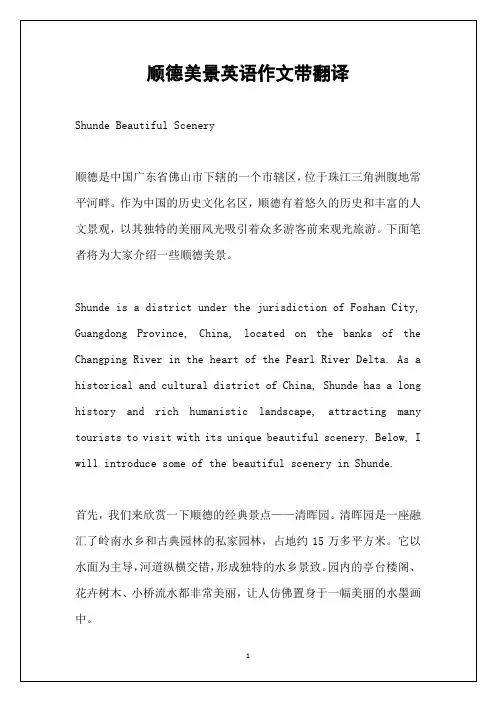
Exploring the Charms of Qinghui GardenNestled in the heart of China's cultural capital, Beijing, Qinghui Garden stands as a timeless testament tothe elegance and refinement of traditional Chinese garden design. Boasting a rich history dating back to the Ming Dynasty, this garden is not just a patch of green in the city; it's a sanctuary where one can escape the hustle and bustle to find peace and tranquility.Upon entering Qinghui Garden, one is immediatelygreeted by a picturesque landscape that seems to unfoldlike a scroll of ancient poetry. The intricate layout ofthe garden, with its carefully planned pavilions, bridges, and ponds, is a masterful display of harmonious spatial relationships. The use of water features, such as theserene lotus pond, creates a sense of depth and tranquility, while the meticulous placement of rocks, trees, and flowers adds visual interest and texture.The garden's architectural elements are equally impressive. The pavilions and teahouses, with their elegant roofs and intricate carvings, are not just places of repose but also works of art. Each detail, from the delicatelattice windows to the intricate carvings on the beams, reflects a deep respect for traditional Chinese culture and craftsmanship.Walking through Qinghui Garden, it's easy to imagine the scenes of ancient times when scholars and poets gathered here to compose verses and discuss philosophy. The garden's serene atmosphere seems to inspire a sense of tranquility and reflection, making it a perfect setting for contemplative walks or quiet conversations.However, Qinghui Garden is not just a museum of the past; it's also a vibrant space that hosts various cultural activities and events. From traditional tea ceremonies to garden concerts, these events allow visitors to experience the garden in a more interactive and engaging way.In conclusion, Qinghui Garden is much more than just a place of beauty; it's a living testament to the rich cultural heritage of China. Its harmonious blend of natural beauty and cultural elegance makes it a must-visit destination for anyone interested in Chinese culture and architecture. As you walk through its gates, you're notjust stepping into a garden; you're stepping into a worldof tranquility, history, and cultural richness.**探寻清晖园的韵味**位于中国文化之都北京的心脏地带,清晖园不仅是一座历史悠久的古典园林,更是中国传统园林设计的优雅与精致的永恒见证。
清晖园旅游介绍作文英语Title: Embracing the Serenity of Qinghui GardenNestled amidst the bustling cityscape of Shunde District, Foshan City, Guangdong Province, Qinghui Garden stands as a serene oasis, a testament to the rich cultural heritage and exquisite artistry of the Lingnan region. This enchanting garden, designated as one of China's Top Ten Gardens and a National AAAA-rated Tourist Attraction, invites visitors on a journey through time, where history, art, and nature intertwine harmoniously.A Glimpse into HistoryOriginating from the Ming Dynasty, Qinghui Garden was initially constructed as the residence of Huang Shijun, a scholar and statesman who held the prestigious title of Grand Secretary. Subsequently, it was acquired and expanded by the Long family, a clan of scholars and officials, who transformed it into a garden of exquisite beauty and profound cultural significance. Today, the garden spans an impressive 22,000 square meters, boasting a history that spans centuries and a legacy that continues to captivate visitors from all walks of life.A Tapestry of Art and NatureStepping into Qinghui Garden is akin to stepping into a dreamlike world where nature and architecture blend seamlessly. The garden's layout is a masterful blend of symmetry and asymmetry, with intricate paths leading to pavilions, bridges, and ponds, each offering a unique perspective and a profound sense of tranquility. The ponds, with their crystal-clear waters, mirror the surrounding foliage and architecture, creating a serene and peaceful atmosphere. The bridges, adorned with intricate carvings and elegant designs, add a touch of sophistication to the overall aesthetic.Architectural MarvelsThe garden's pavilions and rooms are architectural marvels, each structure a testament to the skilled craftsmanship of the Chinese. The Ship Hall, the garden's central attraction, is a two-story imitation of the iconic "Zidongting" boats found on the Pearl River, embodying the essence of Lingnan architecture. Its design, with its curved corridors and water-ripple motifs, evokes a sense of being aboard a floating palace. Other notable structures include the Bixi Cottage, Chengyi Pavilion, Xiyin Study, and Zhuyuan (Bamboo Garden), each with its own unique charm and historical significance.Floral SplendorQinghui Garden is also renowned for its lush greenery and diverse flora. With over 200 species of plants, including numerous century-old trees and exotic species, the garden is a verdant paradise. The gardens are adorned with a myriad of flowers and fruits, many of which are unique to Lingnan, creating a vibrant and colorful backdrop for visitors to enjoy.Cultural TreasuresBeyond its natural beauty, Qinghui Garden houses numerous cultural treasures. The garden is adorned with exquisite calligraphy by renowned scholars such as Li Zhaoluo, Li Wentian, and He Shaoji, adding a touch of literary elegance to the surroundings. Furthermore, the garden has been designated as a National Key Cultural Relic Protection Unit, reflecting its importance in preserving and promoting Chinese cultural heritage.A Journey Through TimeVisiting Qinghui Garden is more than just a leisurely stroll through a picturesque landscape; it is a journey through time, where one can sense the rhythms of history and appreciate the beauty of nature. The garden's harmonious blend of ancient architecture, exquisite gardens, and rich cultural heritage serves as a reminder of the enduring spirit of Chinese culture and the rich diversity it has to offer.In conclusion, Qinghui Garden is a must-visit destination for anyone seeking to immerse themselves in the beauty and history of Lingnan culture. Whether you are an avid traveler, a history buff, or simply someone who appreciates the finer things in life, Qinghui Garden promises to leave a lasting impression on your heart and mind.。
清晖园英文作文Qinghui Garden is a famous classical garden in China, located in the city of Hangzhou. It is known for its beautiful landscapes, elegant architecture, and richcultural heritage. The garden was first built during the Ming Dynasty and has been well-preserved and restored over the centuries.The garden is a perfect representation of Chinese garden design principles, with its carefully planned layout, harmonious combination of natural elements and man-made structures, and intricate details in every corner. Walking through the garden, one can enjoy the sight of pavilions, bridges, ponds, and rockeries, all carefully arranged to create a serene and peaceful atmosphere.Not only is Qinghui Garden a feast for the eyes, but it also holds great historical and cultural significance. The garden has been a source of inspiration for poets, painters, and scholars throughout the ages, and it continues to be a popular destination for tourists and locals alike.中文:清晖园是中国著名的古典园林,位于杭州市。
The Charms of Qinghui GardenNestled in the heart of China's bustling Guangdong province, lies a serene oasis known as Qinghui Garden. This garden, a testament to the rich cultural heritage of the region, is not just a physical space; it's a tapestry of history, art, and nature, unravelling the elegance and refinement of Chinese gardening.Stepping into Qinghui Garden is like stepping into a different world. The serenity of the place is immediately apparent, with its meticulously designed landscapes and well-maintained greenery. The garden's layout is a harmonious blend of symmetry and asymmetry, with paths leading to various pavilions, bridges, and ponds, each offering a unique perspective and a sense of tranquility. The water features of the garden are particularly noteworthy. The ponds, with their clear, still waters, reflect the surrounding foliage and architecture, creating a serene and peaceful atmosphere. The bridges that span these ponds, with their intricate carvings and elegant designs, add a touch of elegance to the overall aesthetic.The garden's pavilions and rooms are equally impressive. Each structure is a testament to the skilled craftsmanshipof the Chinese, with intricate carvings, colorful paintings, and elegant furniture. The attention to detail in these structures is astonishing, with every element designed to enhance the overall aesthetic and ambiance of the garden.But what truly sets Qinghui Garden apart is its ability to blend harmoniously with its natural surroundings. The garden seems to grow out of the landscape, with its paths following the contours of the land and its buildings blending seamlessly into the surrounding foliage. This seamless integration of nature and architecture is a hallmark of Chinese garden design, and Qinghui Garden executes it beautifully.Qinghui Garden is not just a place; it's an experience. It's a journey through time, where one can sense therhythms of history and appreciate the beauty of nature.It's a testament to the enduring spirit of Chinese culture, a reminder of the rich and diverse heritage that this country has to offer.**清晖园的韵味**在中国繁华的广东省中心,隐藏着一处宁静的绿洲,那就是清晖园。
用英语介绍粤晖园的作文Yuehui Garden: A Cultural Oasis;Located in the heart of Guangzhou, Yuehui Garden is a captivating cultural destination that offers a serene escape from the bustling city life. With its rich history, breathtaking scenery, and diverse range of attractions, it has become a must-visit location for locals and tourists alike.Yuehui Garden, also known as the Garden of Lingnan Culture, showcases the unique charm and elegance of Lingnan architecture and landscaping. The garden's design incorporates traditional elements such as winding paths, delicate bridges, and picturesque pavilions. These features not only add to its aesthetic appeal but also create a harmonious balance between man-made structures and nature.One of the highlights of Yuehui Garden is the Lingnan-style residences, which provide a glimpse into the region's rich cultural heritage. These well-preserved houses exhibit intricate wood carvings, exquisite ceramic tiles, and vibrant frescoes. Visitors can explore the different rooms, courtyards, and gardens, immersing themselves in the architectural splendor of Lingnan culture. In addition to its architectural wonders, Yuehui Garden is also home to various cultural activities and exhibitions. The garden regularly hosts traditional music performances, calligraphy demonstrations, and tea ceremonies, allowing visitors to experience the essence of Lingnan traditions. The exhibitions showcase ancient artifacts, traditional crafts, and artwork, providing insights into the history and customs of the region.Nature enthusiasts will also appreciate the natural beauty within the garden. Lush greenery, colorful flowers, and tranquil ponds create a tranquil ambiance, making it an ideal spot for relaxation and contemplation. Strolling along the meandering paths, visitors can appreciate the serenity of the surroundings while admiring the delicate blend of nature and human design. Yuehui Garden serves as a cultural oasis, preserving the heritage of Lingnan culture and offering a sanctuary for those seeking respite from the city's hustle and bustle. Whether you are interested in history, architecture, or simply immersing yourself in natural beauty, this enchanting garden is sure to leave a lasting impression.So, step into Yuehui Garden and embark on a journey through the rich tapestry of Lingnan culture. Discover the elegance, tranquility, and artistic traditions that make this garden a true gem in Guangzhou's cultural landscape.。
芙蓉园英语作文Fu Rong Garden is one of the most beautiful and famous gardens in China. It is located in the city of Changsha, andit is a popular tourist destination for both locals andvisitors from all over the world.The garden is famous for its breathtaking natural scenery, including beautiful flowers, lush greenery, and serene lakes. Visitors can take leisurely strolls along the winding paths and admire the colorful blooms of various plants and flowers. There are also many pavilions and bridges scatteredthroughout the garden, adding to its charm and beauty.In addition to its natural beauty, Fu Rong Garden alsohas a rich cultural history. It was originally built duringthe Qing Dynasty and has been meticulously maintained and preserved over the centuries. The architecture and design ofthe garden reflect the traditional Chinese style, with intricate details and elegant structures.One of the highlights of Fu Rong Garden is the annual flower festival, which takes place in the spring. During this time, the garden is filled with an array of vibrant flowers, creating a stunning display of color and fragrance. Visitors can also enjoy traditional music and dance performances, as well as sample delicious local cuisine.Overall, Fu Rong Garden is a must-visit destination for anyone who loves nature and Chinese culture. Its beauty and tranquility make it the perfect place to relax and escape from the hustle and bustle of city life. Whether you are a nature enthusiast, a history buff, or simply looking for a peaceful retreat, Fu Rong Garden has something to offer for everyone.。
Qing Hui YuanOutline1.Introduce2.Attractions2.1Xi Yin bookstore and Zhen Yan Zhai (惜阴书屋和真砚斋) 2.2Chuan Ting (船厅)2.3Bi Xi Cao Tang (碧溪草堂)2.4Feng Lai Peak(凤来峰)3.The features of Qing Hui Yuan3.1 The features of architectural art3.2 Distinct Lingnan features4. Historical development4.1 The origin of Qing Hui Yuan4.2 The forming period of Qing Hui Yuan4.3 Protection and development period5. CultureZhuangyuan Culture (状元文化)6. Conclusion提纲1.概况2.旅游景点2.1惜阴书屋和真砚斋2.2船厅2.3碧溪草堂2.4凤来峰3.清晖园的特色3.1建筑特色3.2鲜明的岭南特色4. 历史演变4.1 清晖园渊源4.2 成型时期4.3 保护与扩展时期5. 文化状元文化6.总结Qing Hui Yuan1.IntroductionLocated on Shunde of Foshan city, in Guangdong province, Qing Hui Yuan in Shunde, was built in 1800. It was originally Huang garden(黄氏花园) built by Huang Shijun, a scholar in the late Ming dynasty. The existing buildings were mainly built in the Qing Dynasty jiaqing years. After the establishment of New China, government repaired and extended Qing Hui Yuan time after time, which made the area of old Qing Hui Yuan expand from more than 7000 square meters to 22000 square meters.The garden, built in order to return grace of parents, was named“Qinghui”,meaning warm sunlight as well as the kindness of parents. it is a typical garden symbolizing private garden and a classical garden art masterpiece in the south of China. Qing Hui Yuan in Shunde, one of the famous gardens in Guangdong in the early Qing dynasty, not only was named one of eight sights of sheep city(羊城八景) but also has been listed as provincial-level key cultural relics protection units.2.Attractions2.1 Xi Yin bookstore and Zhen Yan Zhai (惜阴书屋和真砚斋)Xi Yin bookstore is connected to Zhen Yan Zhai. Xi Yin bookstore and Zhen Yan Zhai compose a garden residence. The study with courtyard, built In the Qing Dynasty jiaqing years, was a place where the children in the owner’s family studied and the owner received literati. Xi Yin bookstore means that the owner encourage children to cherish time and study hard. There is a four angles kiosk(四角亭) on the left of Xi Yin bookstore,originally called Fengtai(凤台). Then, for it was blown down by the strong wind, it was built in 1888 and was named four angles kiosk(四角亭). Next to the kiosk is a vivid lion mountain(狮山)。
Three lions, snuggling each other, crouch bamboo palm grove. The rocky mountain and the lion up the tower(狮子上楼台)of Ke Yuan in Dongguan are known as mountain masterpiece of Lingnan garden. Around the lion mountain is all kinds of rare flowers and uncommon trees. There is white camellia with about one hundred years. Although the trunk is death, it is still full of branches between winter and spring.2.2 Chuan Ting (船厅)Chuan Ting, like a boat, is the architectural essence of all Chuan Ting, because its design is unique. It is a two-story lou fang(楼舫),which imitate the chuan ting style of Jichang Garden(寄畅园) in Suzhou and Purple hole boat (紫洞艇) of Qing Dynasty that is on the Pearl River. It is divided three parts: prow、cabin andstern, which is the only example in the architectural design in China. Chuan Ting is surrounded by water as though it is built on the water. Best of all is a willow tree on the right of ship's rail, like a bamboo secured the prow. There is a wisteria binding on the willow tree, like a rope secured the boat. Between the forehold and the capsule has the hollowed-out woodcut, which is Plantain double-sided design, as interval.It is also called Miss Building(小姐楼). It is said that the owner had a darling daughter, who was very beautiful, had virtuous behavior and mastered of literature. She was the apple of her parents' eye, so her parents specially constructed the building for her.2.3Bi Xi Cao Tang (碧溪草堂)Built in the Qing Dynasty daoguang period, Bi Xi Cao Tang was the main living room of the master in the past. The main entrance, called aureole cover (圆光罩), is round hole shape. Chaozhou woodcarving with the themes of flowers, birds, insects, fish and fruits is on the quaint doors and Windows, screen door and door curtain. Under the bottom of the two doors were engraved with 48 "shou" words having different forms, called Baishou picture (百寿图). In generally, one hundred words form a Baishou picture, but the Baishou picture only have ninety-six "shou" words. View on the reason why the picture only have ninety-six "shou" words vary from people to people. Some people said that the owner intentionally do it, thinking that people maybe know the owner’s opinion about Confucianism and Buddhism from the picture. Others said that artisans made mistakes in design. In addition, there is a big brick carving below the window, carved bamboos and a picture entitled “Qing Yan Yi Lou picture”(轻烟挹露图).2.4Feng Lai Peak(凤来峰)The name of Feng Lai Peak comes from Fengcheng(凤城). Feng Lai Peak was built in accordance with a stone mountain composition, a classic “wind-cloud convergence”(风云际汇) picture. It was made of Shandong’s hua shi gang shi(花石岗石) listed as a tribute in Song Dynasty. People used nearly three thousand tons of rock to construct it. The peak, 12.8 meters in height, is the largest and highest hua shi gang shi mountain(花石岗石山)in Guangdong province. There is a trail on the rocky mountain. Artificial waterfall streams off the top of the peak. Long lake under the waterfall separated by a stone bridge and tracery wall whose shape is waveform. The surface of the water is as smooth as a mirror in Du Yun Xuan(读云轩), while the water splashed in all directions in Feng Lai Peak. Therefore, there are two kinds of landscape including movement and peace on the lake. Moreover, if you climb up Feng Lai Peak, you can overlook a panoramic view of Qing Hui Yuan.3.The features of Qing Hui Yuan3.1 The features of architecture(1)All kinds of building typesBuildings in Qing Hui Yuan are abundant, and it almost gathers the various architectural forms of the Chinese classical garden, such as kiosk, shed, hall, pavilion, veranda, boat and so on. They are high, or low, or grand, or magnificent…… Different building types have different purpose, which shows us different aesthetic style.(2) Unique architectural appearanceThe buildings in garden generally do not emphasize the decoration of the roof and eave angle is not upward. In façade treatment, it use conjunction window with door, which forms screen door like french sash. Also, it uses a large number of stained glass to enchase latticework, which makes architectural appearance more spectacular.(3) Colorful windowsThe windows of buildings in the garden have various forms. Some are inlaid in wall; some are ornamental perforated window(漏窗) enchased with ceramic ware, and etc. The latticework of window constitute different pattern. Inlay material are stained glass of Qing dynasty, which is rarely found in the decorative style of classical gardens and makes windows more beautiful.(4)Gathering various art formsQing Hui Yuan adopts various art forms, so that while we appreciate the art of architecture, we also enjoy a variety of other artworks. It mainly uses three styles: art(including painting, wood carving, glass etching, pottery and so on), literature and calligraphy. Many of the sculptures are embedded in the walls and under the eaves. A lot of handwriting of ancient calligrapher made plaques and couplets are hung. Panes are inlaid with beautiful poetry or mythological roles.3.2Distinct Lingnan featuresQing Hui Yuan has distinct Lingnan features, because it, located on Lingnan, have been influenced by Lingnan unique geographical environment, natural climate, economy and culture.(1)A number of Lingnan’s trees, birds and flowers are the themes of the building in Qing Hui Yuan. For instance, plantain is commonly used as the adornment theme. Moreover, the garden plants a variety of unique flowers, grass and trees in lingnan.(2)In order to adapt to the hot and humid climate of lingnan, the garden firstly adopts unique layout—the front is lower and sparser than the rear. The front is a open rectangle pool, while the rear is dense residential area. The layout is very beneficial to ventilation and makes the summer cool wind constantly blow to backyard. And dense arrangement in backyard can reduce the radiation of sunshine. Secondly, architectural image, is handy flexible, and fully open. Also, It combines doors with windows, which forms screen door like panoptic window.(3)Qing Hui Yuan is full of Pearl River Delta’s the charm of watery place(珠三角的水乡韵). Waterscape takes up a great portion. And it has a number of fishponds and often uses water as courtyard, instead of ground. For example, Chuan Ting is surrounded by water as though it is built on the water.(4)Qing Hui Yuan is open and compatible. For Lingnan, located in the coastal, has been influenced by western culture, Qing Hui Yuan absorbs the western ways of landscape, integrates of Chinese and western. It uses a lot of color glass, which makes Qing Hui Yuan different from the gardens in the north. And it uses inerratic geometry, such as Rectangle pool. Also, it adopts romanesque arched Windows and doors.4.Historical development4.1 The origin of Qing Hui YuanQing Hui Yuan, built in 1621 AD, was originally Huang Shijun’s mansion. Huang Shijun was a Zhuangyuan(状元) and then became minister of Rituals as well as grand secretary (大学士). To bring glory on his ancestors(光宗耀祖),he built Huang family ancestral temple(黄家祠), Tianzhang pavilion(天章阁) and so on, which are all around the garden. In the Qianlong years Qing Dynasty, Huang family(黄家) declined, so courtyard gradually became deserted. And then Long Yinshi (龙应时) bought the abandoned site, but at that time the buildings of Huang almost were destroyed.4.2 The forming period of Qing Hui YuanAfter the courtyard belonged to Long family(龙家), Long Yinshi (龙应时) descended it to his sons, Long Tingzi(龙廷梓) and Long Tinghuai(龙廷槐). In 1788, Long Tinghuai passed an examination of Jinshi(进士) and became the academician courtyard compiling(翰林院编修). After he resigned and returned home in 1788, he expanded the courtyard to Serve his elderly mother. In 1806, Long Yinshi’s son, Long Yuanren(龙元任) invited Li Zhaoluo, a calligrapher, to write three words, “Qing Hui Yuan” above the main entrance. Subsequently, after several generations of Long Yinshi continue to carefully construct, modified andprocessed, the pattern of the garden began to finalize the design in the early years of the republic of China. During the Anti-Japanese War, Long family went aboard to avoid war, so the courtyard is gradually broken.4.3 Protection and development periodIn recent years, the government in shunde district repaired on a large scale. In 1959, Tao Zhu, a CPC guangdong provincial party committee secretary, came to visit the garden and granted special fund to protect it. At the same year, county government repaired and expanded Qing Hui Yuan, so that the area expanded from more than 3000 square meters to about ten thousand square meters. Since 1996, municipal party committee and municipal government in Shunde have invested a great deal human resources, material resources and financial resources to extend, repair it and added several building sites, in view of the garden’s history, art and ornamental value.5.CultureZhuangyuan Culture (状元文化)Since Song Dynasty, Shunde had altogether 4 Zhuangyuan(状元), 1 Tanhua(探花),261 Jinshi(进士) and 1288 Jiuren(举人). And Qing Hui Yuan was a place in which the first Zhuangyuan, many Jinshi(进士) and Tanhua(探花) lived. It was originally a Zhuangyuan’s mansion in Ming Dynasty. In Qing Dynasty, the master’s family, Long family(龙家), had 3 Jinshi, which became proverbial at that time. Several generations of master were prominent figures of the society and a lot of celebrities also came to Qing Hui Yuan, so it left a large number of celebrities’ works as well as footprint. If visitors visit it, they can be motivated and enhance the personal quality.6.ConclusionQing Hui Yuan, incorporating the culture of Ming Dynasty and Qing Dynasty, Lingnan ancientgarden architecture, Jiangnan garden art and water features of Pearl River Delta, is the outstanding representative of Lingnan gardens. With the development of economy, we should not only protect cultural heritage but also boost its boundless vitality. Over the course of history, we ought to continue to breathe new life and meaning.。